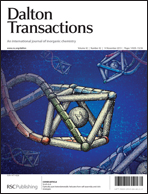Heterometallic Pb–Ag iodometallates [Ln(DMF)8]2Pb3Ag10I22 [Ln = Ce(1), Pr(2)] were prepared by the reactions of PbI2, AgNO3 and KI in dimethylformamide (DMF) templated by [Ln(DMF)8]3+ complexes formed in situ by stirring LnCl3 in DMF. The same reactions in the absence of AgNO3 or PbI2 afforded iodoplumbate [Pr(DMF)9]2[Pr(DMF)8]Pb11I31 (3), and iodoargentates [Ln(DMF)8]Ag6I9 [Ln = Ce(4), Pr(5)], respectively. Compounds 1 and 2 contain a ternary one-dimensional polymeric [Pb3Ag10I22]6− anion self-assembled from five AgI4, one PbI6 and one PbI4 primary units via edge- and face-sharing. Twelve PbI6 octahedra are interlinked via sharing of common faces to generate a 1D zigzag [Pb11I319−]n chain in 3, which represents a new member of iodoplumbate aggregates. In 4 and 5, three AgI4 tetrahedra connect through common edges to form the [Ag6I12]6− building block. The [Ag6I12]6− blocks are further interlinked by sharing common edges, resulting in the 1D [Ag6I93−]n chain. Optical absorption spectra showed that the synthesized Ag-iodoplumbate and iodoplumbate have potential for being used as semiconductors. Our results show that heterometallic halometallate properties can be tuned by combining structural units with different symmetries, enabling the synthesis of specific functional materials.

You have access to this article
 Please wait while we load your content...
Something went wrong. Try again?
Please wait while we load your content...
Something went wrong. Try again?


 Please wait while we load your content...
Please wait while we load your content...